Mathea Ford's Blog, page 7
January 17, 2025
Dining Out with Kidney Disease Eat Smart Stay Healthy-Podcast

Eating out can be a delightful experience, but for individuals managing Chronic Kidney Disease (CKD), it comes with unique challenges. Restaurants often use high-sodium, high-fat, and processed ingredients to enhance flavor, which can clash with CKD dietary restrictions. Moreover, oversized portions can exceed nutritional limits, making it harder to monitor sodium, potassium, phosphorus, and protein intake.
For More Recipes and Ideas --->> Get Your Free Meals and Recipes That Are Perfect for Pre-Dialysis Diets, Pre-Dialysis with Diabetes, or Dialysis Diets.
Tips for Navigating MenusDining out doesnât have to mean compromising on health. Here are some practical strategies:Advocate for Your NeedsPolitely request dressings, gravies, or sauces to be served on the side to control intake.Ask for low-sodium or salt-free meal preparations, as many chefs can accommodate such requests.Substitute high-potassium sides, like potatoes, with kidney-friendly alternatives such as steamed vegetables.Choose Healthier OptionsLook for grilled or steamed vegetables and lean proteins like chicken or fish instead of fried or breaded dishes.Favor whole grains, such as quinoa or brown rice, and dishes prepared with olive oil and fresh herbs rather than salt.Be Portion-WiseConsider splitting meals with a companion or ordering half portions if available.Start with low-calorie appetizers like salads or vegetable-based soups to avoid overeating.Monitor Condiments and ExtrasBe cautious of sodium-rich sauces such as ketchup, BBQ sauce, and teriyaki glaze.Opt for oil-based dressings or fresh herb toppings for added flavor without extra sodium.Restaurants with CKD-Friendly OptionsCertain cuisines and establishments are more accommodating for CKD dietary needs:Fast Food:Choose healthier options like salads, grilled chicken sandwiches, or veggie burgers. Avoid fries and sugary drinks.Asian Cuisine:
Select steamed or stir-fried vegetables, tofu, or grilled proteins, but ask for reduced soy sauce usage.Special Requests:
Many restaurants allow substitutions such as quinoa for rice or avocado for high-fat toppings. Donât hesitate to inquire.Benefits of Dining Out for CKD PatientsDining out offers more than just food; it can be a social and psychological boost.Social Interaction: Enjoy time with friends and family while exploring new settings.Variety in Meals: Many restaurants offer dishes like fresh seafood or vegetarian options that align with CKD dietary guidelines.Convenience: Prepared meals can fit within your dietary needs when modifications are requested.Preparation and PlanningPreparation is key to a successful dining experience:Before Dining OutResearch nutritional information on the restaurantâs website.Familiarize yourself with CKD-friendly ingredients to make better choices.During the MealAsk about cooking methods to ensure meals are not loaded with sodium or phosphorus additives.Choose dishes with fresh, natural ingredients while avoiding processed foods.Balancing Home Cooking and Eating Out
While home cooking provides the best control over ingredients and preparation, dining out doesnât have to be avoided entirely. With proper planning, clear communication, and mindful eating, itâs possible to enjoy restaurant meals while adhering to CKD dietary guidelines.Dining out with CKD can be a rewarding experience with a little preparation and creativity. Focus on moderation, communicate your needs, and make smart menu choices to enjoy a meal that satisfies both your palate and health goals.
Would you like to refine this further, or should we work on additional materials like social media posts or visuals?
Learn more About Are Sweet Potatoes Safe for Your Kidneys The Truth About This Superfood
The post Dining Out with Kidney Disease Eat Smart Stay Healthy-Podcast appeared first on Renal Diet HQ.
January 10, 2025
Are Sweet Potatoes Safe for Your Kidneys? The Truth About This Superfood

The vibrant orange hue of sweet potatoes makes them a popular choice for their natural sweetness and nutritional benefits. However, for individuals managing Chronic Kidney Disease (CKD), itâs crucial to understand how sweet potatoes fit into a kidney-friendly diet. This guide explores their nutritional value, potential risks, and tips for safe consumption.
For More Recipes and Ideas --->> Get Your Free Meals and Recipes That Are Perfect for Pre-Dialysis Diets, Pre-Dialysis with Diabetes, or Dialysis Diets.
Nutritional Benefits of Sweet PotatoesSweet potatoes are nutrient-dense, packed with vitamins and minerals that support overall health. They contain:
Beta Carotene: A powerful antioxidant that protects cells from oxidative damage and supports eye health.Vitamin C: Boosts immune function and enhances the bodyâs ability to fight illnesses.Dietary Fiber: Aids digestion and helps regulate cholesterol levels, contributing to heart health.Essential Minerals: Includes magnesium, manganese, copper, iron, and calcium.These nutrients contribute to improved cardiac function, reduced inflammation, and better overall well-being, making sweet potatoes a valuable addition to a balanced diet.
Sweet Potatoes and Potassium: What CKD Patients Need to KnowFor individuals with CKD, managing potassium intake is critical, as high potassium levels can lead to dangerous imbalances, including irregular heartbeats. Sweet potatoes are relatively high in potassium, with up to 700 milligrams per serving. While they offer many health benefits, their potassium content requires careful consideration for CKD patients.
How to Safely Enjoy Sweet Potatoes with CKDSweet potatoes can still be part of a kidney-friendly meal plan when consumed in moderation and prepared properly. Here are some tips:
Portion Control: Limit consumption to half a cup per serving and no more than one serving per week, as recommended by your dietitian.Potassium Leaching: Peel and slice sweet potatoes into ¼-inch thick slices, then soak them in cold water for at least two hours, changing the water every four hours. Rinse with warm water and cook in five times the amount of water to reduce potassium content.Boiling and Steaming: Boil or steam sweet potatoes to allow potassium to leach into the cooking water. These methods make them safer for CKD patients.Roasting and Grilling: For variety, roast or grill sweet potatoes. Toss cubes with olive oil and roast at 425°F for 15-20 minutes, or grill over medium heat for 5-7 minutes per side.Alternatives to Sweet Potatoes for a Kidney-Friendly DietIf sweet potatoes donât fit your dietary needs, there are plenty of other kidney-friendly vegetables to explore, including:
CauliflowerSquashTurnipsCarrotsEach of these options offers unique flavors and nutritional benefits, providing variety in a kidney-friendly diet.
Sweet Potatoes vs. Yams: Whatâs the Difference?Though often used interchangeably, sweet potatoes and yams are distinct:
Sweet Potatoes: Softer texture, sweeter flavor, and rich in beta carotene. Lower in potassium compared to yams, making them a better choice for CKD patients.Yams: Starchier, less sweet, and higher in potassium. They require careful preparation, such as leaching or boiling, to reduce potassium content.Final Thoughts: Including Sweet Potatoes in a Kidney-Friendly DietSweet potatoes are a nutrient-rich food that can support kidney health when consumed mindfully. Their high levels of antioxidants, vitamins, and fiber make them a valuable addition to meals, but portion control and proper preparation are key. Always consult with a healthcare provider or dietitian to determine how sweet potatoes can fit into your personalized kidney-friendly diet.
Learn more About Dietary Protein and Kidney Health A Must Watch Guide for CKD Patients
The post Are Sweet Potatoes Safe for Your Kidneys? The Truth About This Superfood appeared first on Renal Diet HQ.
January 6, 2025
Vegetarian Sloppy Joes
Vegetarian Sloppy Joe Wraps are a delightful, plant-based twist on a classic favorite. This recipe combines hearty mushrooms, kidney beans, and a savory blend of vegetables, all wrapped in crisp romaine lettuce leaves for a fresh and satisfying meal. Perfect for those with CKD, itâs a kidney-friendly option thatâs packed with flavor and nutrition.
As a Registered Dietitian with over 25 years of experience, I specialize in creating kidney-friendly recipes that are both nutritious and delicious. Inspired by my personal journey of supporting loved ones with CKD, Iâve dedicated my career to helping others enjoy healthy, satisfying meals while managing their condition. This recipe reflects my commitment to evidence-based nutrition and practical, easy-to-follow dietary advice.
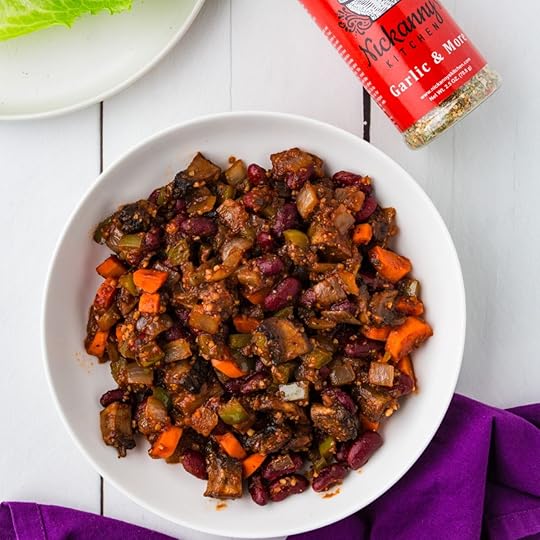
Vegetarian Sloppy Joe recipes like this one are ideal for those managing CKD because they rely on fresh, low-sodium ingredients and nutrient-packed vegetables. By using homemade vegetable stock and low-salt tomato paste, this recipe ensures a kidney-friendly approach without compromising on flavor. Packed with protein from kidney beans and served in crisp lettuce wraps, itâs a healthy and satisfying option for your diet.
I know many people love doing plant based recipes for a CKD diet, so I would recommend you also try our rice, corn and black bean burritos or the roasted cauliflower steaks from our kidney friendly vegetarian entrees category. You can try these with Parmesan roasted carrots and baked pears for dessert!
[feast_advanced_jump_to]For More Recipes and Ideas --->> Get Your Free Meals and Recipes That Are Perfect for Pre-Dialysis Diets, Pre-Dialysis with Diabetes, or Dialysis Diets.
Ingredients in Vegetarian Sloppy Joes RecipesThese Vegetarian Sloppy Joe Beans combine fresh vegetables and kidney beans for a hearty, flavorful filling. Perfectly balanced for a kidney-friendly diet, they make a satisfying wrap option thatâs both nutritious and delicious.
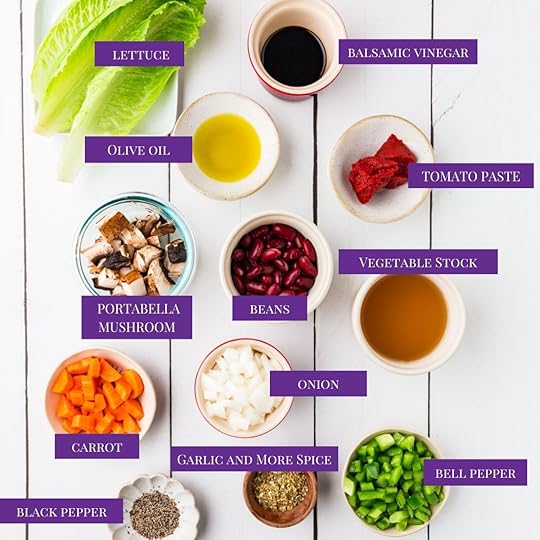 Olive Oil - Provides a healthy fat base for cooking and enhances flavor.Onion - Adds a mild sweetness and depth of flavor.Garlic Seasoning - Brings savory and aromatic notes to the dish.Green Bell Pepper - Adds a fresh crunch and a hint of sweetness.Carrot - Contributes natural sweetness and a bit of texture.Mushrooms - Provide a hearty, savory flavor similar to meat.Black Pepper - Adds a warm, spicy kick.Kidney Beans - Bring protein and a creamy texture to the dish.Balsamic Vinegar - Balances the flavors with tangy sweetness.Tomato Paste - Enhances the tomato flavor and gives richness.Vegetable Stock - Adds moisture and a savory base.Romaine Lettuce Leaves - Acts as a fresh, crisp wrap for the filling.
Olive Oil - Provides a healthy fat base for cooking and enhances flavor.Onion - Adds a mild sweetness and depth of flavor.Garlic Seasoning - Brings savory and aromatic notes to the dish.Green Bell Pepper - Adds a fresh crunch and a hint of sweetness.Carrot - Contributes natural sweetness and a bit of texture.Mushrooms - Provide a hearty, savory flavor similar to meat.Black Pepper - Adds a warm, spicy kick.Kidney Beans - Bring protein and a creamy texture to the dish.Balsamic Vinegar - Balances the flavors with tangy sweetness.Tomato Paste - Enhances the tomato flavor and gives richness.Vegetable Stock - Adds moisture and a savory base.Romaine Lettuce Leaves - Acts as a fresh, crisp wrap for the filling.See recipe card for quantities.
How To Make Vegetarian Sloppy JoesThese Vegetarian Sloppy Joes with Mushroom are easy to make and perfect for a quick, kidney-friendly meal. With just a few steps, youâll have a flavorful, satisfying dish ready to enjoy.
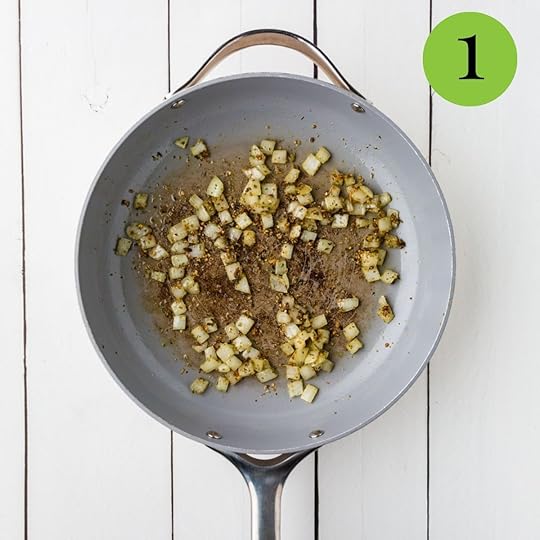
Heat olive oil in a large skillet over medium high heat. Add onion and garlic and more seasoning and saute, stirring occasionally for 4-5 minutes or just until onion is soft and translucent.
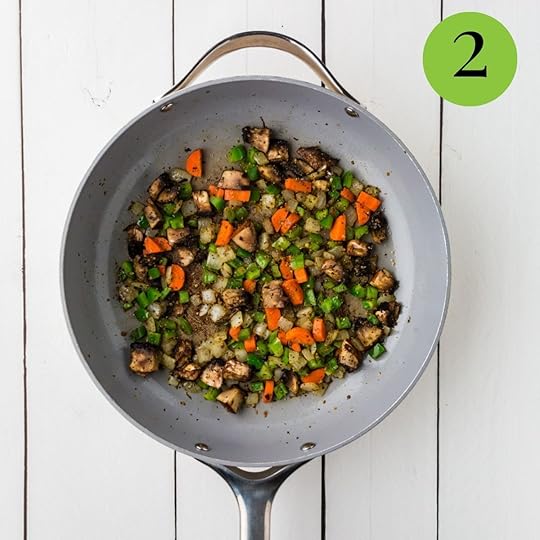
Add green pepper, carrot, mushrooms, and black pepper. Stir to combine. Cook until vegetables soften and develop a bit of color, approximately 4-5 minutes, stirring occasionally. Rinse kidney beans prior to use in recipe.
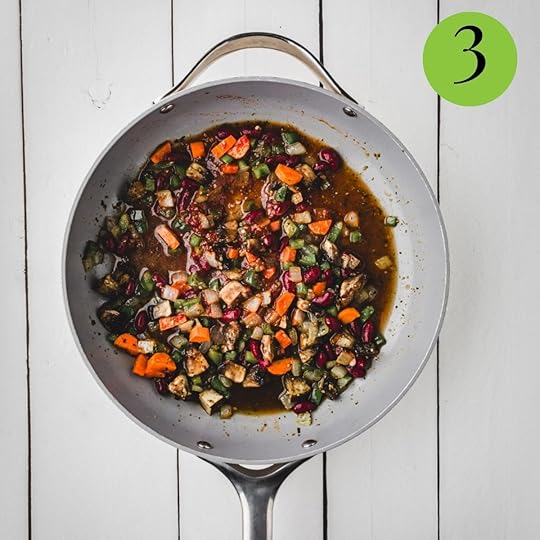
Reduce heat to medium and add kidney beans, balsamic vinegar, tomato paste and vegetable stock. Stir to combine and continue cooking until mixture is heated through and excess liquid is absorbed. About 2-3 more minutes.
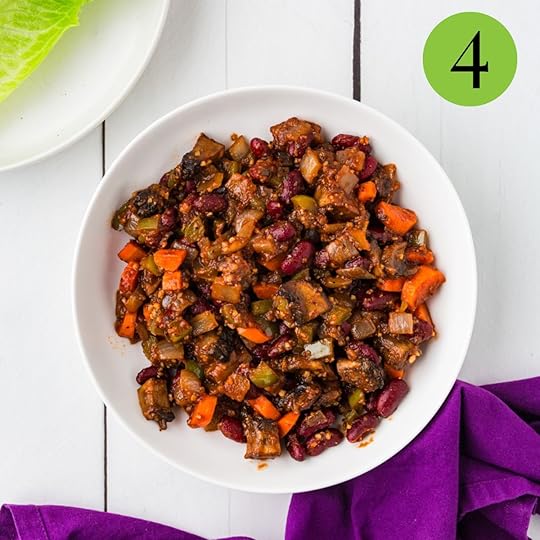
Remove from heat and let cool for 5 minutes. To serve, divide vegetable mixture among the Romaine lettuce leaves and wrap the lettuce around the filling.
Hint: Add the balsamic vinegar and tomato paste towards the end of cooking for a rich, tangy finish.
Variations on Vegan Sloppy JoesVegetarian Sloppy Joes with Mushrooms can be adapted to fit a variety of tastes while staying kidney-friendly.
Use diced zucchini instead of green peppers for a milder flavor.Substitute baby bella mushrooms for a slightly earthier taste.Add a pinch of smoked paprika for a subtle smoky note.StorageRefrigeration: Store the cooked vegetable filling in an airtight container in the refrigerator for up to 3 days. Keep the lettuce leaves separate to maintain their freshness.Freezing: For longer storage, freeze the filling in a freezer-safe container for up to 1 month. Thaw overnight in the refrigerator before reheating.Reheating: Warm the filling in a skillet over low heat or in the microwave. Add a splash of vegetable stock if it seems dry.Top tipUse fresh lettuce leaves that are sturdy enough to hold the filling without tearing.
FAQs about Vegetarian Sloppy JoesCan I serve this with something other than lettuce wraps?Yes, the filling pairs well with whole-grain tortillas, pita bread, or even over brown rice.
Is this recipe gluten-free?Yes, the recipe is naturally gluten-free as written, provided all your ingredients (like stock and seasonings) are certified gluten-free.
How can I make this recipe spicier?Add a pinch of cayenne pepper or a few drops of hot sauce to the vegetable mixture for a spicy kick.
Related Vegetarian RecipesLooking for other recipes like this? Try these:
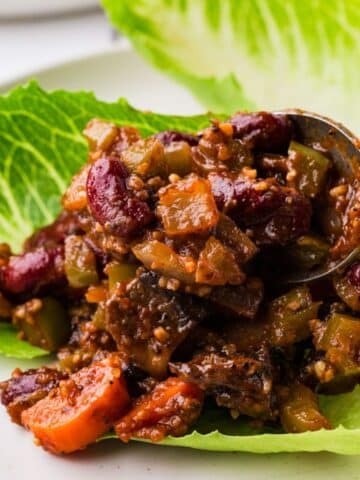 Vegetarian Sloppy Joes
Vegetarian Sloppy Joes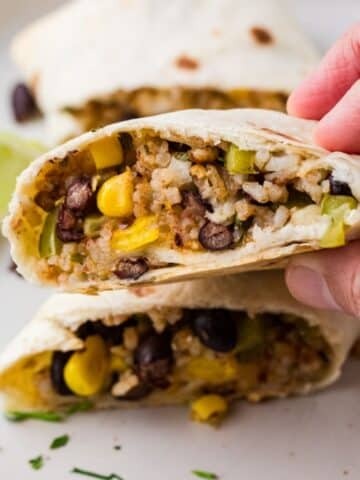 Black Bean and Rice Burrito
Black Bean and Rice Burrito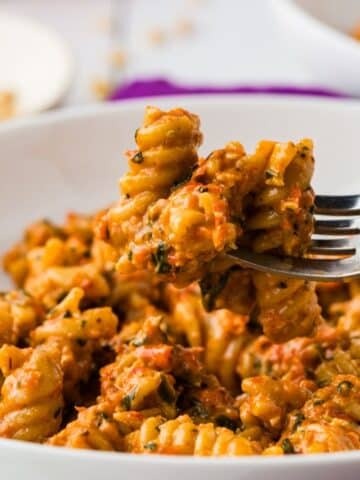 Roasted Red Pepper Pesto Pasta
Roasted Red Pepper Pesto Pasta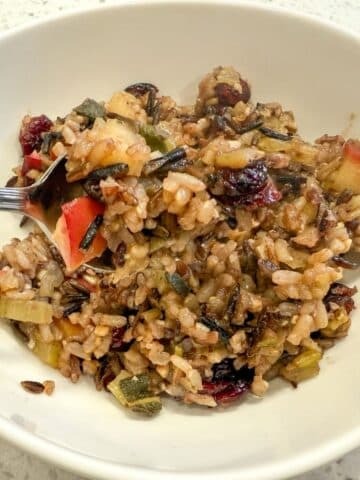 Wild Rice StuffingPairing with Meatless Wraps
Wild Rice StuffingPairing with Meatless WrapsThese are my favorite dishes to serve with Sloppy Joes with no Meat:
 Baked Pears
Baked Pears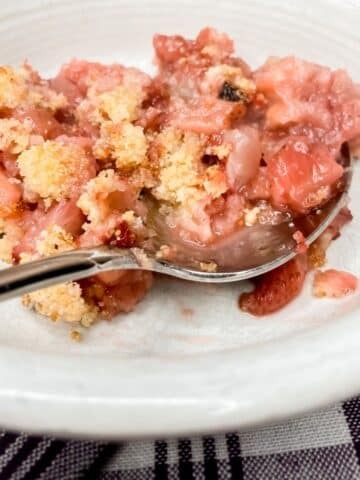 Healthy Strawberry Cobbler
Healthy Strawberry Cobbler Dairy Free Creme Brulee
Dairy Free Creme Brulee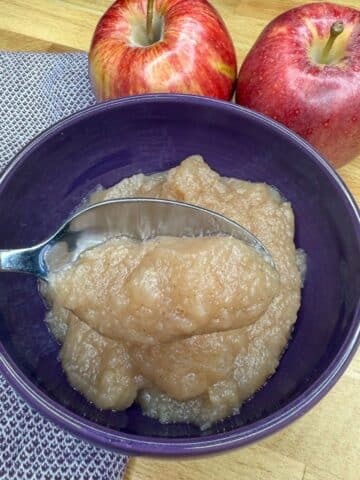 Sugar Free Applesauce
Sugar Free ApplesauceIf you tried this Recipe or any other recipe on my website, please please leave a star rating and let me know how it goes in the comments below. I love hearing from you!
Recipe PrintVegetarian Sloppy Joe Wraps#wprm-recipe-user-rating-0 .wprm-rating-star.wprm-rating-star-full svg * { fill: #343434; }#wprm-recipe-user-rating-0 .wprm-rating-star.wprm-rating-star-33 svg * { fill: url(#wprm-recipe-user-rating-0-33); }#wprm-recipe-user-rating-0 .wprm-rating-star.wprm-rating-star-50 svg * { fill: url(#wprm-recipe-user-rating-0-50); }#wprm-recipe-user-rating-0 .wprm-rating-star.wprm-rating-star-66 svg * { fill: url(#wprm-recipe-user-rating-0-66); }linearGradient#wprm-recipe-user-rating-0-33 stop { stop-color: #343434; }linearGradient#wprm-recipe-user-rating-0-50 stop { stop-color: #343434; }linearGradient#wprm-recipe-user-rating-0-66 stop { stop-color: #343434; }#wprm-recipe-user-rating-0.wprm-user-rating-allowed.wprm-user-rating-not-voted:not(.wprm-user-rating-voting) svg * { fill-opacity: 0.3; }These Vegetarian Sloppy Joe Wraps are a kidney-friendly, plant-based take on a classic dish. Quick to make, theyâre packed with flavor and nutrition!Course EntreeCuisine AmericanDiet Low Fat, Low Salt, VegetarianPrep Time 20 minutes minutesServings 2Calories 149kcalAuthor Mathea Ford, RDN, LD, MBAIngredients1 tablespoon OLIVE OIL salad or cooking½ cup ONION RAW, CHOPPED2 teaspoon Garlic and More Spice½ cup GREEN PEPPER SWEET, RAW (BELL), CHOPPED¼ cup CARROT RAW, CHOPPED½ cup MUSHROOM PORTABELLA, RAW, DICED½ teaspoon PEPPER BLACK, GROUND¼ cup KIDNEY BEAN RED1 tablespoon VINEGAR BALSAMIC2 teaspoon TOMATO PASTE NO SALT, canned2 ounces Homemade Vegetable Stock ZYD¼ head LETTUCE COS OR ROMAINE, RAW, Approximately 4 leavesGet ingredients with
PrintVegetarian Sloppy Joe Wraps#wprm-recipe-user-rating-0 .wprm-rating-star.wprm-rating-star-full svg * { fill: #343434; }#wprm-recipe-user-rating-0 .wprm-rating-star.wprm-rating-star-33 svg * { fill: url(#wprm-recipe-user-rating-0-33); }#wprm-recipe-user-rating-0 .wprm-rating-star.wprm-rating-star-50 svg * { fill: url(#wprm-recipe-user-rating-0-50); }#wprm-recipe-user-rating-0 .wprm-rating-star.wprm-rating-star-66 svg * { fill: url(#wprm-recipe-user-rating-0-66); }linearGradient#wprm-recipe-user-rating-0-33 stop { stop-color: #343434; }linearGradient#wprm-recipe-user-rating-0-50 stop { stop-color: #343434; }linearGradient#wprm-recipe-user-rating-0-66 stop { stop-color: #343434; }#wprm-recipe-user-rating-0.wprm-user-rating-allowed.wprm-user-rating-not-voted:not(.wprm-user-rating-voting) svg * { fill-opacity: 0.3; }These Vegetarian Sloppy Joe Wraps are a kidney-friendly, plant-based take on a classic dish. Quick to make, theyâre packed with flavor and nutrition!Course EntreeCuisine AmericanDiet Low Fat, Low Salt, VegetarianPrep Time 20 minutes minutesServings 2Calories 149kcalAuthor Mathea Ford, RDN, LD, MBAIngredients1 tablespoon OLIVE OIL salad or cooking½ cup ONION RAW, CHOPPED2 teaspoon Garlic and More Spice½ cup GREEN PEPPER SWEET, RAW (BELL), CHOPPED¼ cup CARROT RAW, CHOPPED½ cup MUSHROOM PORTABELLA, RAW, DICED½ teaspoon PEPPER BLACK, GROUND¼ cup KIDNEY BEAN RED1 tablespoon VINEGAR BALSAMIC2 teaspoon TOMATO PASTE NO SALT, canned2 ounces Homemade Vegetable Stock ZYD¼ head LETTUCE COS OR ROMAINE, RAW, Approximately 4 leavesGet ingredients with  InstructionsHeat olive oil in a large skillet over medium high heat. Add onion and garlic and more seasoning and saute, stirring occasionally for 4-5 minutes or just until onion is soft and translucent.Add green pepper, carrot, mushrooms, and black pepper. Stir to combine. Cook until vegetables soften and develop a bit of color, approximately 4-5 minutes, stirring occasionally. Rinse kidney beans prior to use in recipe.Reduce heat to medium and add kidney beans, balsamic vinegar, tomato paste and vegetable stock. Stir to combine and continue cooking until mixture is heated through and excess liquid is absorbed. About 2-3 more minutes.Remove from heat and let cool for 5 minutes. To serve, divide vegetable mixture among the Romaine lettuce leaves and wrap the lettuce around the filling.NutritionCalories: 149kcal | Carbohydrates: 18g | Protein: 5g | Fat: 8g | Saturated Fat: 1g | Polyunsaturated Fat: 1g | Monounsaturated Fat: 5g | Trans Fat: 0g | Cholesterol: 0mg | Sodium: 41mg | Potassium: 706mg | Fiber: 5g | Sugar: 7g | Vitamin A: 3244IU | Vitamin C: 38mg | Vitamin D: 0.1µg | Calcium: 44mg | Iron: 2mg | Phosphorus: 99mgCheck Out Our Meal Plans For People With Chronic Kidney Disease (CKD)
InstructionsHeat olive oil in a large skillet over medium high heat. Add onion and garlic and more seasoning and saute, stirring occasionally for 4-5 minutes or just until onion is soft and translucent.Add green pepper, carrot, mushrooms, and black pepper. Stir to combine. Cook until vegetables soften and develop a bit of color, approximately 4-5 minutes, stirring occasionally. Rinse kidney beans prior to use in recipe.Reduce heat to medium and add kidney beans, balsamic vinegar, tomato paste and vegetable stock. Stir to combine and continue cooking until mixture is heated through and excess liquid is absorbed. About 2-3 more minutes.Remove from heat and let cool for 5 minutes. To serve, divide vegetable mixture among the Romaine lettuce leaves and wrap the lettuce around the filling.NutritionCalories: 149kcal | Carbohydrates: 18g | Protein: 5g | Fat: 8g | Saturated Fat: 1g | Polyunsaturated Fat: 1g | Monounsaturated Fat: 5g | Trans Fat: 0g | Cholesterol: 0mg | Sodium: 41mg | Potassium: 706mg | Fiber: 5g | Sugar: 7g | Vitamin A: 3244IU | Vitamin C: 38mg | Vitamin D: 0.1µg | Calcium: 44mg | Iron: 2mg | Phosphorus: 99mgCheck Out Our Meal Plans For People With Chronic Kidney Disease (CKD)The post Vegetarian Sloppy Joes appeared first on Renal Diet HQ.
January 3, 2025
Dietary Protein and Kidney Health A Must Watch Guide for CKD Patients-Podcast

Protein is essential for maintaining health, supporting tissue repair, and promoting overall vitality. However, for those managing Chronic Kidney Disease (CKD), protein intake must be carefully controlled. The kidneys, which help filter waste from the body, become less efficient as kidney disease progresses, so managing what goes into the body is vital. In this post, weâll explore how protein affects kidney function, why managing protein intake is crucial for CKD patients, and how you can make mindful choices to maintain kidney health.
For More Recipes and Ideas --->> Get Your Free Meals and Recipes That Are Perfect for Pre-Dialysis Diets, Pre-Dialysis with Diabetes, or Dialysis Diets.
Understanding Protein and Its Role in CKDProteins are crucial for many bodily functions. They are the building blocks for muscles, tissues, enzymes, and hormones. Additionally, proteins play an essential role in immune function, energy production, and cell repair. While protein is necessary for overall health, the kidneys are responsible for filtering the waste produced when the body breaks down protein. For those with CKD, the kidneys are less efficient at this task, meaning managing protein intake becomes vital to prevent excess waste from accumulating in the body.
As kidney function declines, the body struggles to filter out excess protein waste. This can contribute to further kidney damage if protein intake isnât monitored carefully. For CKD patients, protein management is about balancing sufficient intake to maintain health without overburdening the kidneys.
Why Protein Management is Essential for CKD PatientsIn CKD, the kidneys lose their ability to filter waste efficiently, and the bodyâs normal process of breaking down protein can put stress on these already compromised kidneys. Without careful management, high levels of protein can exacerbate kidney damage. Too much protein can lead to increased production of waste products like urea and creatinine, which the kidneys struggle to eliminate.
On the flip side, too little protein can lead to malnutrition, muscle wasting, and fatigue. This is why balancing protein intake is so important for CKD patientsâtoo much can worsen the condition, but too little can lead to other health issues.
Low-Protein Diet: A Key Strategy for CKDFor CKD patients, a low-protein diet is often recommended to reduce the workload on the kidneys. A low-protein diet typically consists of 0.6 to 0.8 grams of protein per kilogram of body weight. This helps decrease the waste products the kidneys need to filter, providing relief to the kidneys and potentially slowing the progression of the disease.
A low-protein diet can also have benefits beyond kidney protection, such as helping lower cholesterol levels and blood pressure, which are both essential for individuals with CKD.
Key elements of a low-protein kidney-friendly diet include:Fruits and Vegetables: Opt for kidney-friendly, low-potassium fruits and vegetables that support overall health without overloading the kidneys.Whole Grains: Foods like brown rice and quinoa are excellent sources of energy without the high protein content that meats provide.Healthy Fats: Incorporate healthy fats such as those found in olive oil and avocados to keep meals satisfying and nutritious without adding excess protein.Choosing the Right Protein Sources for CKDProtein sources matter greatly for CKD patients. Not all proteins are created equal, and certain sources are gentler on the kidneys than others. High-quality proteins, particularly those that are lower in phosphorus and potassium, are ideal.
Kidney-friendly protein sources include:Fish: Fish is a great protein choice due to its high-quality protein and lower phosphorus content compared to red meats.Eggs: Eggs are a good source of high-quality protein and can be easily incorporated into many kidney-friendly meals.Lean Meats: Skinless chicken, turkey, and lean cuts of beef are acceptable options when consumed in moderate amounts.Plant-Based Proteins: Tofu, legumes, and nuts provide plant-based protein options that are generally lower in phosphorus and potassium than animal-based sources.By choosing the right protein sources, CKD patients can still meet their nutritional needs while protecting their kidneys. It's important to avoid processed meats and high-sodium foods, which can contribute to further kidney stress.
Understanding Protein Portion Sizes for CKDPortion sizes are just as important as the type of protein consumed. Overconsumption of even kidney-friendly protein can put undue stress on the kidneys. Understanding the appropriate portion size for protein can help maintain balance in your diet.
For most non-dialysis CKD patients, the recommended protein intake is about 3 oz of protein per meal, which roughly equates to the size of a deck of cards. Itâs important to note that protein intake should be spread throughout the day rather than consumed all at once.
For dialysis patients, protein needs are higher because protein is lost during the dialysis process. However, even with this increased need, careful management of portion sizes is still essential to avoid overloading the kidneys.
Special Considerations for Dialysis PatientsDialysis patients face additional challenges when it comes to managing protein intake. Since dialysis removes waste products and proteins from the blood, itâs important for patients to replace the protein lost during treatments. Therefore, dialysis patients are typically advised to consume more proteinâusually about 1.0 to 1.2 grams of protein per kilogram of body weight.
In addition to protein, dialysis patients must be mindful of their intake of other minerals such as sodium, potassium, and phosphorus. For example, potassium-rich foods like bananas and oranges may need to be limited, depending on individual needs. Limiting sodium intake is also crucial to prevent further kidney strain.
The Risks of Too Much Protein for CKD PatientsExcessive protein intake can accelerate kidney damage in CKD patients. As the kidneys filter out protein waste, a high-protein diet increases the workload on the kidneys, potentially reducing kidney function and leading to further complications.
Moreover, consuming more protein than necessary can lead to high blood urea nitrogen (BUN) levels and increased creatinine, which are markers for kidney dysfunction. By adhering to a balanced protein intake that aligns with individual needs, CKD patients can avoid these risks and help slow the progression of kidney disease.
Plant-Based Proteins: Balancing Nutrients for CKDPlant-based proteins are an excellent option for CKD patients, particularly those looking to reduce their intake of animal proteins. Sources like tofu, lentils, and beans provide protein without the added phosphorus and potassium found in many animal-based options. However, itâs important to keep in mind that some plant proteins, such as legumes, can be higher in potassium and phosphorus, so portion control is still important.
Balancing plant-based proteins with other foods, such as low-potassium vegetables and healthy fats, can help ensure that CKD patients receive all the nutrients they need without overburdening the kidneys.
Managing protein intake is crucial for anyone living with Chronic Kidney Disease (CKD). By choosing high-quality protein sources, adjusting portion sizes, and balancing plant-based and animal-based proteins, CKD patients can maintain proper nutrition while protecting kidney function. Whether you are in the early stages of CKD or managing your condition with dialysis, protein management plays a pivotal role in slowing disease progression and maintaining overall health.
Consult with a registered dietitian to create a personalized protein plan that aligns with your CKD stage and dietary needs. With careful planning and mindful choices, CKD patients can enjoy a healthy, balanced diet that supports their kidneys and enhances their quality of life.
Learn more about Mastering SMART Goals for Chronic Kidney Disease Take Control of Your Health Today
The post Dietary Protein and Kidney Health A Must Watch Guide for CKD Patients-Podcast appeared first on Renal Diet HQ.
Dietary Protein and Kidney Health A MustWatch Guide for CKD Patients-Podcast

Protein is essential for maintaining health, supporting tissue repair, and promoting overall vitality. However, for those managing Chronic Kidney Disease (CKD), protein intake must be carefully controlled. The kidneys, which help filter waste from the body, become less efficient as kidney disease progresses, so managing what goes into the body is vital. In this post, weâll explore how protein affects kidney function, why managing protein intake is crucial for CKD patients, and how you can make mindful choices to maintain kidney health.
For More Recipes and Ideas --->> Get Your Free Meals and Recipes That Are Perfect for Pre-Dialysis Diets, Pre-Dialysis with Diabetes, or Dialysis Diets.
Understanding Protein and Its Role in CKDProteins are crucial for many bodily functions. They are the building blocks for muscles, tissues, enzymes, and hormones. Additionally, proteins play an essential role in immune function, energy production, and cell repair. While protein is necessary for overall health, the kidneys are responsible for filtering the waste produced when the body breaks down protein. For those with CKD, the kidneys are less efficient at this task, meaning managing protein intake becomes vital to prevent excess waste from accumulating in the body.
As kidney function declines, the body struggles to filter out excess protein waste. This can contribute to further kidney damage if protein intake isnât monitored carefully. For CKD patients, protein management is about balancing sufficient intake to maintain health without overburdening the kidneys.
Why Protein Management is Essential for CKD PatientsIn CKD, the kidneys lose their ability to filter waste efficiently, and the bodyâs normal process of breaking down protein can put stress on these already compromised kidneys. Without careful management, high levels of protein can exacerbate kidney damage. Too much protein can lead to increased production of waste products like urea and creatinine, which the kidneys struggle to eliminate.
On the flip side, too little protein can lead to malnutrition, muscle wasting, and fatigue. This is why balancing protein intake is so important for CKD patientsâtoo much can worsen the condition, but too little can lead to other health issues.
Low-Protein Diet: A Key Strategy for CKDFor CKD patients, a low-protein diet is often recommended to reduce the workload on the kidneys. A low-protein diet typically consists of 0.6 to 0.8 grams of protein per kilogram of body weight. This helps decrease the waste products the kidneys need to filter, providing relief to the kidneys and potentially slowing the progression of the disease.
A low-protein diet can also have benefits beyond kidney protection, such as helping lower cholesterol levels and blood pressure, which are both essential for individuals with CKD.
Key elements of a low-protein kidney-friendly diet include:Fruits and Vegetables: Opt for kidney-friendly, low-potassium fruits and vegetables that support overall health without overloading the kidneys.Whole Grains: Foods like brown rice and quinoa are excellent sources of energy without the high protein content that meats provide.Healthy Fats: Incorporate healthy fats such as those found in olive oil and avocados to keep meals satisfying and nutritious without adding excess protein.Choosing the Right Protein Sources for CKDProtein sources matter greatly for CKD patients. Not all proteins are created equal, and certain sources are gentler on the kidneys than others. High-quality proteins, particularly those that are lower in phosphorus and potassium, are ideal.
Kidney-friendly protein sources include:Fish: Fish is a great protein choice due to its high-quality protein and lower phosphorus content compared to red meats.Eggs: Eggs are a good source of high-quality protein and can be easily incorporated into many kidney-friendly meals.Lean Meats: Skinless chicken, turkey, and lean cuts of beef are acceptable options when consumed in moderate amounts.Plant-Based Proteins: Tofu, legumes, and nuts provide plant-based protein options that are generally lower in phosphorus and potassium than animal-based sources.By choosing the right protein sources, CKD patients can still meet their nutritional needs while protecting their kidneys. It's important to avoid processed meats and high-sodium foods, which can contribute to further kidney stress.
Understanding Protein Portion Sizes for CKDPortion sizes are just as important as the type of protein consumed. Overconsumption of even kidney-friendly protein can put undue stress on the kidneys. Understanding the appropriate portion size for protein can help maintain balance in your diet.
For most non-dialysis CKD patients, the recommended protein intake is about 3 oz of protein per meal, which roughly equates to the size of a deck of cards. Itâs important to note that protein intake should be spread throughout the day rather than consumed all at once.
For dialysis patients, protein needs are higher because protein is lost during the dialysis process. However, even with this increased need, careful management of portion sizes is still essential to avoid overloading the kidneys.
Special Considerations for Dialysis PatientsDialysis patients face additional challenges when it comes to managing protein intake. Since dialysis removes waste products and proteins from the blood, itâs important for patients to replace the protein lost during treatments. Therefore, dialysis patients are typically advised to consume more proteinâusually about 1.0 to 1.2 grams of protein per kilogram of body weight.
In addition to protein, dialysis patients must be mindful of their intake of other minerals such as sodium, potassium, and phosphorus. For example, potassium-rich foods like bananas and oranges may need to be limited, depending on individual needs. Limiting sodium intake is also crucial to prevent further kidney strain.
The Risks of Too Much Protein for CKD PatientsExcessive protein intake can accelerate kidney damage in CKD patients. As the kidneys filter out protein waste, a high-protein diet increases the workload on the kidneys, potentially reducing kidney function and leading to further complications.
Moreover, consuming more protein than necessary can lead to high blood urea nitrogen (BUN) levels and increased creatinine, which are markers for kidney dysfunction. By adhering to a balanced protein intake that aligns with individual needs, CKD patients can avoid these risks and help slow the progression of kidney disease.
Plant-Based Proteins: Balancing Nutrients for CKDPlant-based proteins are an excellent option for CKD patients, particularly those looking to reduce their intake of animal proteins. Sources like tofu, lentils, and beans provide protein without the added phosphorus and potassium found in many animal-based options. However, itâs important to keep in mind that some plant proteins, such as legumes, can be higher in potassium and phosphorus, so portion control is still important.
Balancing plant-based proteins with other foods, such as low-potassium vegetables and healthy fats, can help ensure that CKD patients receive all the nutrients they need without overburdening the kidneys.
Managing protein intake is crucial for anyone living with Chronic Kidney Disease (CKD). By choosing high-quality protein sources, adjusting portion sizes, and balancing plant-based and animal-based proteins, CKD patients can maintain proper nutrition while protecting kidney function. Whether you are in the early stages of CKD or managing your condition with dialysis, protein management plays a pivotal role in slowing disease progression and maintaining overall health.
Consult with a registered dietitian to create a personalized protein plan that aligns with your CKD stage and dietary needs. With careful planning and mindful choices, CKD patients can enjoy a healthy, balanced diet that supports their kidneys and enhances their quality of life.
Lear more about Mastering SMART Goals for Chronic Kidney Disease Take Control of Your Health Today
The post Dietary Protein and Kidney Health A MustWatch Guide for CKD Patients-Podcast appeared first on Renal Diet HQ.
January 2, 2025
Black Bean and Rice Burrito
If you're looking for a flavorful and satisfying meal, this black bean and rice burrito recipe is a perfect choice. Packed with protein-rich black beans, vibrant veggies, and a touch of spices, itâs a wholesome dish thatâs easy to prepare and kidney-friendly. These burritos are perfect for meal prepping or enjoying fresh out of the oven!
As a Registered Dietitian with over 25 years of experience specializing in chronic kidney disease, Iâve crafted recipes tailored to meet CKD dietary needs without compromising on flavor. This rice and black bean burrito is a great example of how you can enjoy satisfying meals while supporting kidney health. With ingredients carefully chosen to be low in sodium and full of nutrients, this recipe aligns with evidence-based guidelines for a kidney-friendly diet.
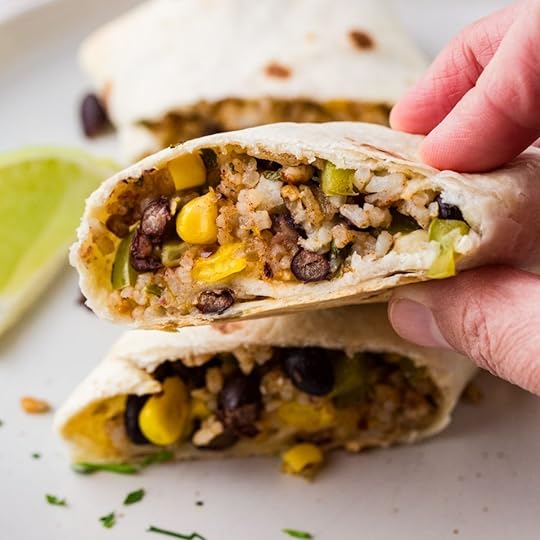
This vegetarian black beans and rice burritos recipe is perfectly suited for those managing chronic kidney disease. It uses low-sodium black beans, fresh vegetables, and a light hand with seasoning to keep sodium levels in check while delivering vibrant flavors. The recipe is also flexible, allowing you to make substitutions to meet your dietary preferences or needs while adhering to kidney-friendly principles.
This recipe uses our Texas Twist and Garlic and More spices from Nickannyskitchen.com. We love these vegan burritos made with corn, black beans and rice with our other vegetarian side dishes like Italian peas or corn pasta salad.
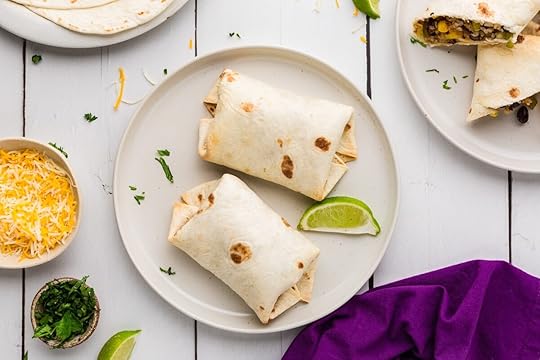 [feast_advanced_jump_to]
[feast_advanced_jump_to]For More Recipes and Ideas --->> Get Your Free Meals and Recipes That Are Perfect for Pre-Dialysis Diets, Pre-Dialysis with Diabetes, or Dialysis Diets.
Ingredients In Black Bean Burritos with RiceThe ingredients in this black bean and rice burrito recipe are simple yet flavorful, combining wholesome staples like rice, beans, and vegetables. Each component is carefully selected to create a delicious and kidney-friendly meal youâll love.
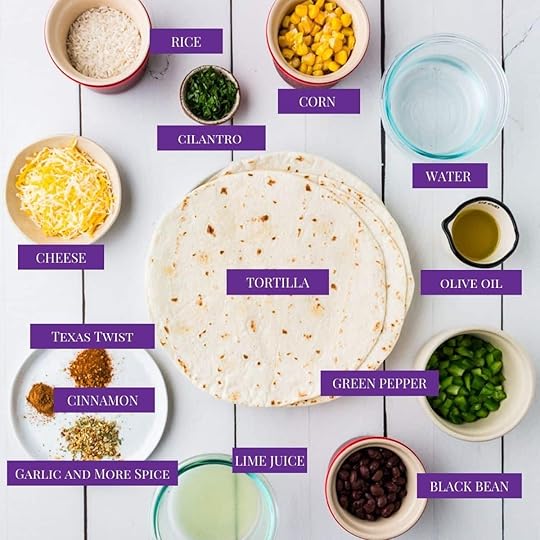 White rice â Adds a hearty and chewy texture to the burrito filling.Water â Used for cooking the rice to the perfect consistency.Olive oil â Enhances flavor and keeps the rice mixture moist.Texas Twist seasoning â Adds a savory and slightly spicy seasoning to the filling.Garlic seasoning â Infuses a rich, aromatic flavor into the dish.Ground cinnamon â Provides a subtle warmth and unique depth to the burrito filling.Low-sodium black beans â Supplies a protein-rich and kidney-friendly base.Frozen corn kernels â Adds sweetness and texture to balance the flavors.Diced green bell pepper â Contributes a fresh crunch and vibrant color.Fresh lime juice â Brightens the flavors with a tangy kick.Chopped cilantro â Lends a refreshing, herbaceous note to the burrito.Flour tortillas (7-8" diameter) â Wraps everything together in a soft and pliable shell.Shredded Mexican cheese blend â Adds a creamy and melty topping to enhance flavor.
White rice â Adds a hearty and chewy texture to the burrito filling.Water â Used for cooking the rice to the perfect consistency.Olive oil â Enhances flavor and keeps the rice mixture moist.Texas Twist seasoning â Adds a savory and slightly spicy seasoning to the filling.Garlic seasoning â Infuses a rich, aromatic flavor into the dish.Ground cinnamon â Provides a subtle warmth and unique depth to the burrito filling.Low-sodium black beans â Supplies a protein-rich and kidney-friendly base.Frozen corn kernels â Adds sweetness and texture to balance the flavors.Diced green bell pepper â Contributes a fresh crunch and vibrant color.Fresh lime juice â Brightens the flavors with a tangy kick.Chopped cilantro â Lends a refreshing, herbaceous note to the burrito.Flour tortillas (7-8" diameter) â Wraps everything together in a soft and pliable shell.Shredded Mexican cheese blend â Adds a creamy and melty topping to enhance flavor.See recipe card for quantities.
How To Make Burritos with Rice and Black BeansMaking these black bean and rice burritos is a breeze! With a few simple steps, you can prepare a flavorful, kidney-friendly meal that's perfect for any occasion.
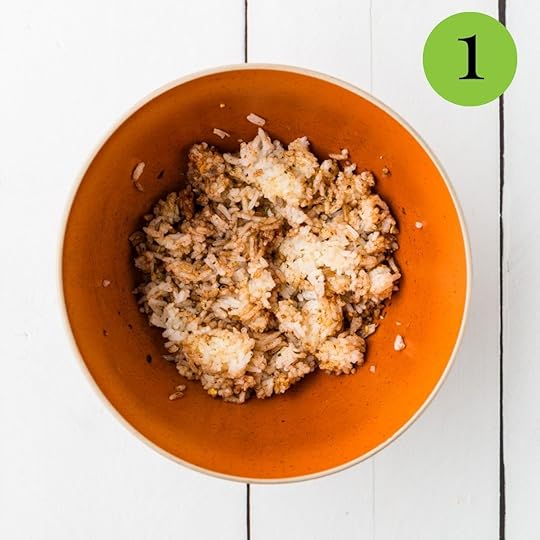
Cook rice as directed on package.
In a medium bowl, toss cooked rice with olive oil, Texas Twist spice, and Garlic and More spice. Add cinnamon and toss to combine.
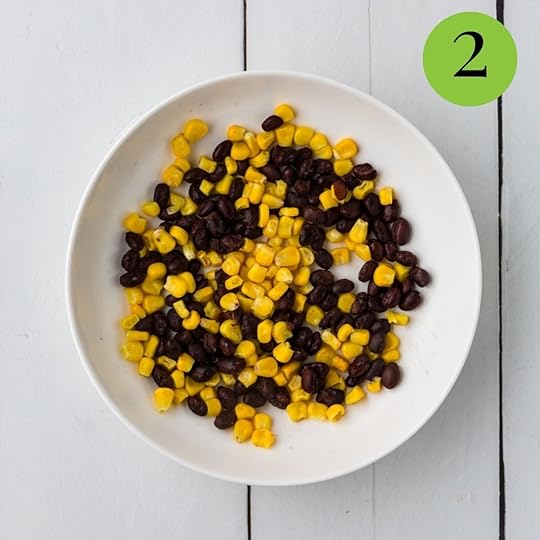
Preheat oven to 400'F. Rinse black beans. Heat corn and black beans in microwave on high for 1 minute.
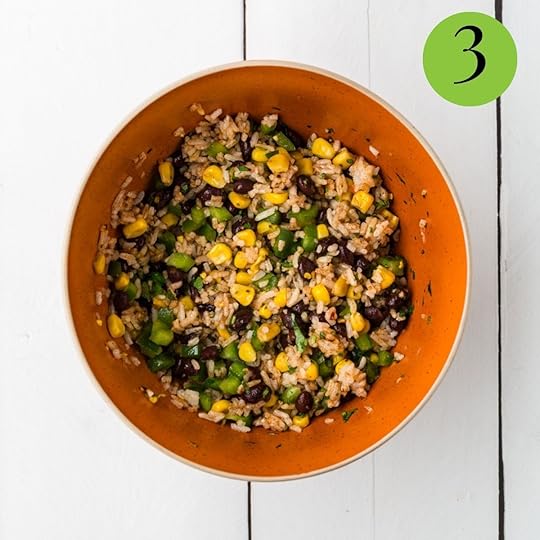
Next, combine warm black beans, corn and bell pepper with the rice. Add lime juice and cilantro and stir to combine.
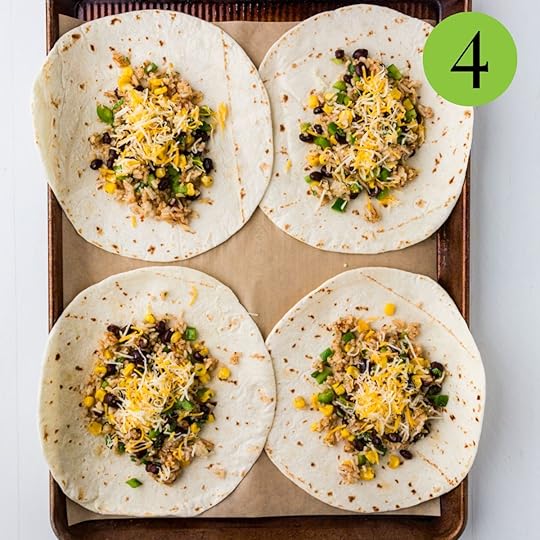
Evenly divide the mixture among the tortillas and top each with the cheese. Roll up each burrito. (At this point you can freeze the burritos and microwave to heat later)
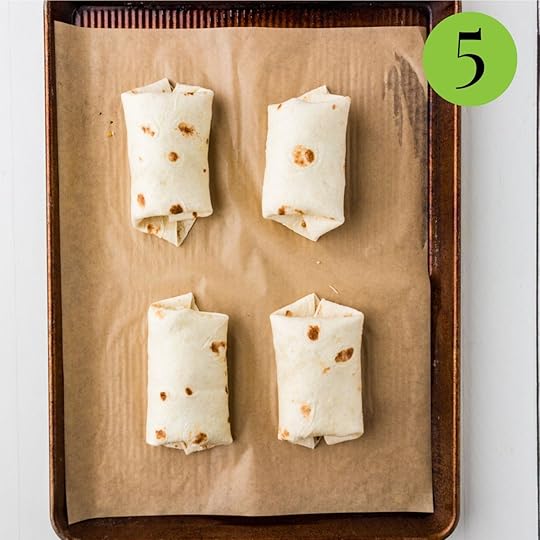
Place on a large baking sheet, seam side down. Place in the hot oven and bake for 10 minutes until the burritos are warmed through and cheese is melted. Remove from oven and enjoy.
Hint: If youâre meal prepping, wrap each burrito individually in foil before freezing for easy grab-and-go reheating.
Variations on Corn Bean and Rice BurritoThis black bean and rice burrito recipe is incredibly versatile, allowing you to get creative while maintaining its kidney-friendly qualities. By swapping in alternative ingredients, you can easily tailor the flavors to your liking or add more variety to your meal plan.
Replace the black beans with low-sodium pinto beans for a slightly different flavor profile.Use whole wheat tortillas instead of flour tortillas for added fiber.Swap the green bell pepper for diced zucchini or another CKD-friendly vegetable for variety.StorageRefrigeration: Store leftover burritos in an airtight container in the refrigerator for up to 3 days. Reheat in the microwave or oven before serving.Freezing: Wrap each burrito individually in foil or plastic wrap and place them in a freezer-safe bag. They can be frozen for up to 3 months.Reheating from Frozen: Microwave wrapped burritos for 2-3 minutes on each side or bake in a 350°F oven for 20-25 minutes until heated through.Top tipWarm the tortillas slightly before filling to make them more pliable and easier to roll.
FAQs about Black Bean Burritos with RiceWhat other vegetables can I add to the burritos?You can add kidney-friendly veggies like diced zucchini, shredded carrots, or sautéed spinach for added nutrients.
Can I make these burritos gluten-free?Absolutely! Use gluten-free tortillas to make the recipe suitable for a gluten-free diet.
Can I omit the cheese to make the recipe dairy-free?Yes, you can skip the cheese or replace it with a dairy-free alternative to suit your dietary needs.
Related Vegetarian EntreesLooking for other recipes like this? Try these:
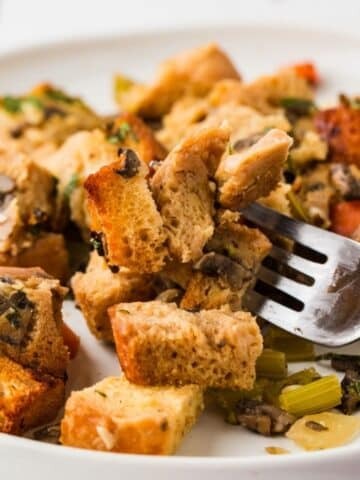 Vegetable Stuffing
Vegetable Stuffing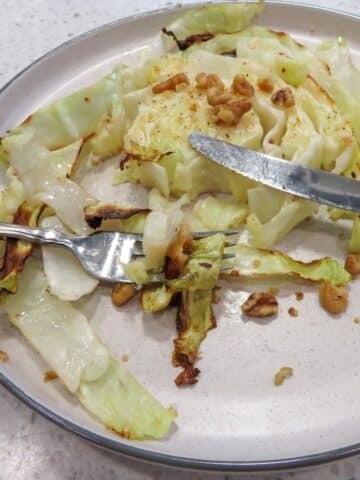 Oven Roasted Cabbage Steaks
Oven Roasted Cabbage Steaks Roasted Cauliflower Steaks with Parmesan
Roasted Cauliflower Steaks with Parmesan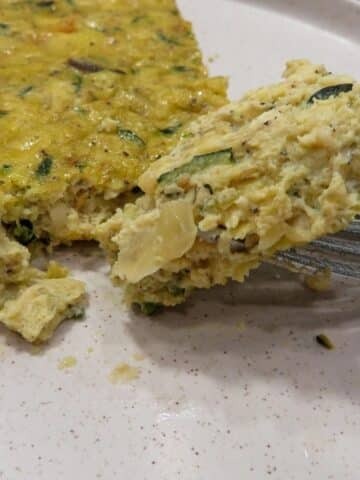 Zucchini Mushroom Frittata
Zucchini Mushroom Frittata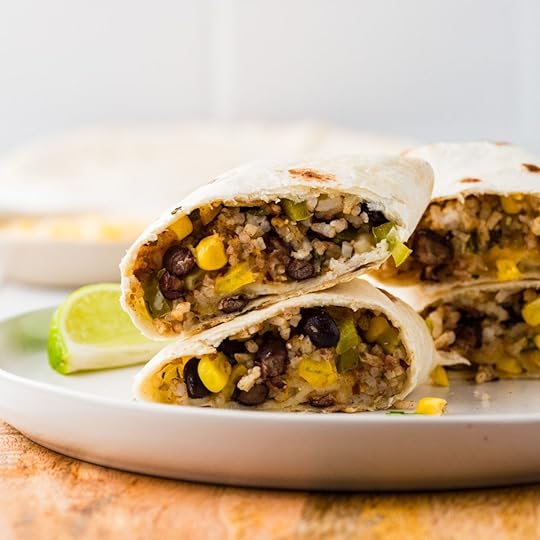 Pairing with Black Bean Rice Burrito Recipe
Pairing with Black Bean Rice Burrito RecipeThese are my favorite dishes to serve with Rice and Black Bean Burritos:
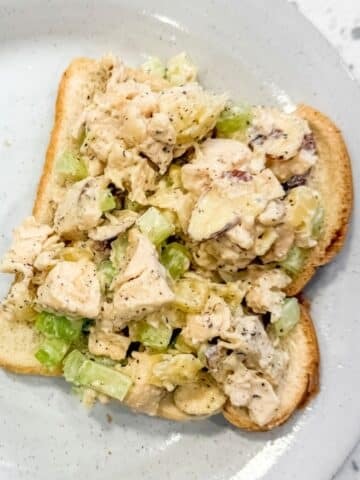 Hawaiian Chicken Salad
Hawaiian Chicken Salad Corn Pasta Salad
Corn Pasta Salad Cornbread Salad
Cornbread Salad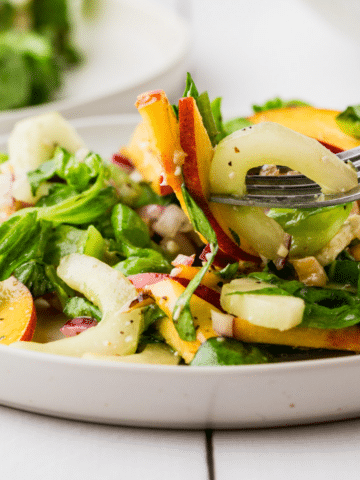 Nectarine Salad
Nectarine SaladIf you tried this Recipe or any other recipe on my website, please please leave a star rating and let me know how it goes in the comments below. I love hearing from you!
Recipe PrintBlack Bean Rice Burrito Recipe#wprm-recipe-user-rating-1 .wprm-rating-star.wprm-rating-star-full svg * { fill: #343434; }#wprm-recipe-user-rating-1 .wprm-rating-star.wprm-rating-star-33 svg * { fill: url(#wprm-recipe-user-rating-1-33); }#wprm-recipe-user-rating-1 .wprm-rating-star.wprm-rating-star-50 svg * { fill: url(#wprm-recipe-user-rating-1-50); }#wprm-recipe-user-rating-1 .wprm-rating-star.wprm-rating-star-66 svg * { fill: url(#wprm-recipe-user-rating-1-66); }linearGradient#wprm-recipe-user-rating-1-33 stop { stop-color: #343434; }linearGradient#wprm-recipe-user-rating-1-50 stop { stop-color: #343434; }linearGradient#wprm-recipe-user-rating-1-66 stop { stop-color: #343434; }#wprm-recipe-user-rating-1.wprm-user-rating-allowed.wprm-user-rating-not-voted:not(.wprm-user-rating-voting) svg * { fill-opacity: 0.3; }Great vegetarian option for you to make for a meal including our garlic and more spice at nickannyskitchen.comCourse EntreeCuisine MexicanDiet Diabetic, Low Fat, Low Salt, VegetarianPrep Time 5 minutes minutesCook Time 15 minutes minutesTotal Time 20 minutes minutesServings 2Calories 266kcalAuthor Mathea Ford, RDN, LD, MBAEquipment1 Large Bowl1 StockpotIngredients¼ cup GLUTINOUS RICE WHITE, RAW½ cup WATER MUNICIPAL1 tablespoon OLIVE OIL salad or cooking½ teaspoon Texas Twist½ teaspoon Garlic and More Spice¼ teaspoon CINNAMON GROUND¼ cup BLACK BEAN LOW SODIUM, mature seeds, canned¼ cup CORN YELLOW, WHOLE KERNEL, frozen¼ cup GREEN PEPPER SWEET, RAW (BELL), Diced1 tablespoon LIME JUICE RAW1 tablespoon CORIANDER RAW (CILANTRO, CHINESE PARSLEY)4 tortilla TORTILLA FLOUR, RTC, 7-8'' diameter2 tablespoon CHEESE MEXICAN BLEND, SHREDDEDGet ingredients with
PrintBlack Bean Rice Burrito Recipe#wprm-recipe-user-rating-1 .wprm-rating-star.wprm-rating-star-full svg * { fill: #343434; }#wprm-recipe-user-rating-1 .wprm-rating-star.wprm-rating-star-33 svg * { fill: url(#wprm-recipe-user-rating-1-33); }#wprm-recipe-user-rating-1 .wprm-rating-star.wprm-rating-star-50 svg * { fill: url(#wprm-recipe-user-rating-1-50); }#wprm-recipe-user-rating-1 .wprm-rating-star.wprm-rating-star-66 svg * { fill: url(#wprm-recipe-user-rating-1-66); }linearGradient#wprm-recipe-user-rating-1-33 stop { stop-color: #343434; }linearGradient#wprm-recipe-user-rating-1-50 stop { stop-color: #343434; }linearGradient#wprm-recipe-user-rating-1-66 stop { stop-color: #343434; }#wprm-recipe-user-rating-1.wprm-user-rating-allowed.wprm-user-rating-not-voted:not(.wprm-user-rating-voting) svg * { fill-opacity: 0.3; }Great vegetarian option for you to make for a meal including our garlic and more spice at nickannyskitchen.comCourse EntreeCuisine MexicanDiet Diabetic, Low Fat, Low Salt, VegetarianPrep Time 5 minutes minutesCook Time 15 minutes minutesTotal Time 20 minutes minutesServings 2Calories 266kcalAuthor Mathea Ford, RDN, LD, MBAEquipment1 Large Bowl1 StockpotIngredients¼ cup GLUTINOUS RICE WHITE, RAW½ cup WATER MUNICIPAL1 tablespoon OLIVE OIL salad or cooking½ teaspoon Texas Twist½ teaspoon Garlic and More Spice¼ teaspoon CINNAMON GROUND¼ cup BLACK BEAN LOW SODIUM, mature seeds, canned¼ cup CORN YELLOW, WHOLE KERNEL, frozen¼ cup GREEN PEPPER SWEET, RAW (BELL), Diced1 tablespoon LIME JUICE RAW1 tablespoon CORIANDER RAW (CILANTRO, CHINESE PARSLEY)4 tortilla TORTILLA FLOUR, RTC, 7-8'' diameter2 tablespoon CHEESE MEXICAN BLEND, SHREDDEDGet ingredients with  InstructionsCook rice as directed on package.In a medium bowl, toss cooked rice with olive oil, Texas Twist spice, and Garlic and More spice. Add cinnamon and toss to combine.Preheat oven to 400'F. Rinse black beans. Heat corn and black beans in microwave on high for 1 minute.Next, combine warm black beans, corn and bell pepper with the rice. Add lime juice and cilantro and stir to combine.Evenly divide the mixture among the tortillas and top each with the cheese. Roll up each burrito. (At this point you can freeze the burritos and microwave to heat later)Place on a large baking sheet, seam side down. Place in the hot oven and bake for 10 minutes until the burritos are warmed through and cheese is melted. Remove from oven and enjoy.If reheating - place burrito on a microwave safe plate and cover with a paper towel. Microwave for 2 minutes, flip and microwave 1 more minute. Let sit for 1 minute to rest.Be careful, product will be hot. (Times vary based on microwave wattage).Serving size is 2 burritos.VideoNutritionCalories: 266kcal | Carbohydrates: 31g | Protein: 8g | Fat: 13g | Saturated Fat: 4g | Polyunsaturated Fat: 1g | Monounsaturated Fat: 7g | Cholesterol: 15mg | Sodium: 149mg | Potassium: 261mg | Fiber: 4g | Sugar: 2g | Vitamin A: 275IU | Vitamin C: 19mg | Vitamin D: 0.1µg | Calcium: 145mg | Iron: 2mg | Phosphorus: 142mgCheck Out Our Meal Plans For People With Chronic Kidney Disease (CKD)
InstructionsCook rice as directed on package.In a medium bowl, toss cooked rice with olive oil, Texas Twist spice, and Garlic and More spice. Add cinnamon and toss to combine.Preheat oven to 400'F. Rinse black beans. Heat corn and black beans in microwave on high for 1 minute.Next, combine warm black beans, corn and bell pepper with the rice. Add lime juice and cilantro and stir to combine.Evenly divide the mixture among the tortillas and top each with the cheese. Roll up each burrito. (At this point you can freeze the burritos and microwave to heat later)Place on a large baking sheet, seam side down. Place in the hot oven and bake for 10 minutes until the burritos are warmed through and cheese is melted. Remove from oven and enjoy.If reheating - place burrito on a microwave safe plate and cover with a paper towel. Microwave for 2 minutes, flip and microwave 1 more minute. Let sit for 1 minute to rest.Be careful, product will be hot. (Times vary based on microwave wattage).Serving size is 2 burritos.VideoNutritionCalories: 266kcal | Carbohydrates: 31g | Protein: 8g | Fat: 13g | Saturated Fat: 4g | Polyunsaturated Fat: 1g | Monounsaturated Fat: 7g | Cholesterol: 15mg | Sodium: 149mg | Potassium: 261mg | Fiber: 4g | Sugar: 2g | Vitamin A: 275IU | Vitamin C: 19mg | Vitamin D: 0.1µg | Calcium: 145mg | Iron: 2mg | Phosphorus: 142mgCheck Out Our Meal Plans For People With Chronic Kidney Disease (CKD)The post Black Bean and Rice Burrito appeared first on Renal Diet HQ.
Baked Ranch Pork Chops
If you're looking for a flavorful, kidney-friendly dinner option, these baked ranch pork chops are a must-try. Packed with tangy ranch seasoning and made with lean pork loin, this recipe is low in sodium yet bursting with flavor, making it ideal for those managing chronic kidney disease (CKD). Plus, the oven-baked method ensures a healthier preparation without compromising on taste.
Iâm passionate about helping individuals with chronic kidney disease (CKD) discover meals that are both flavorful and aligned with their dietary needs. As a Registered Dietitian, I draw from both professional expertise and personal experiences supporting loved ones through CKD to craft recipes like these baked ranch pork chops. Grounded in evidence-based guidelines, this recipe is a delicious, low-sodium choice that makes kidney-friendly eating accessible and enjoyable.
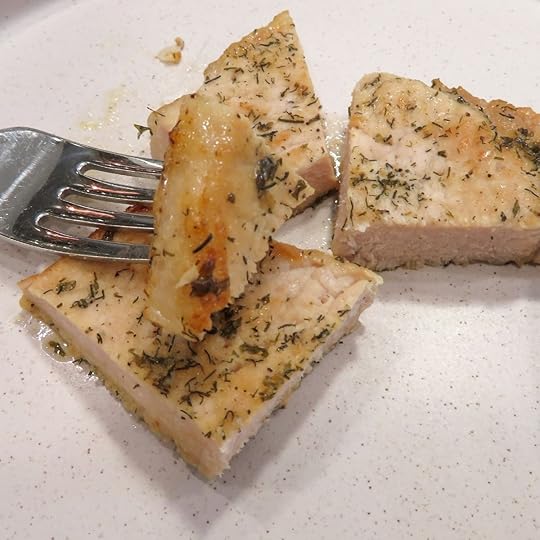
These baked ranch pork chops are a perfect addition to a CKD-friendly meal plan. By using low-sodium ranch seasoning and lean pork center loin, this recipe minimizes sodium and saturated fat while maximizing flavor. With simple preparation and ingredients, itâs an easy way to enjoy a satisfying meal that aligns with kidney health goals.
I love these oven baked pork chops with ranch which uses our low sodium ranch seasoning! You will love to serve them with some of our wild rice stuffing or asparagus pasta as a side dish, or you could try some of our other kidney friendly salads or soups for CKD patients that make a hearty meal.
[feast_advanced_jump_to]For More Recipes and Ideas --->> Get Your Free Meals and Recipes That Are Perfect for Pre-Dialysis Diets, Pre-Dialysis with Diabetes, or Dialysis Diets.
3 Ingredient Ranch Pork ChopsThis recipe uses simple, wholesome ingredients to create flavorful baked ranch pork chops while keeping them kidney-friendly. Each ingredient plays a role in balancing taste, nutrition, and ease of preparation.
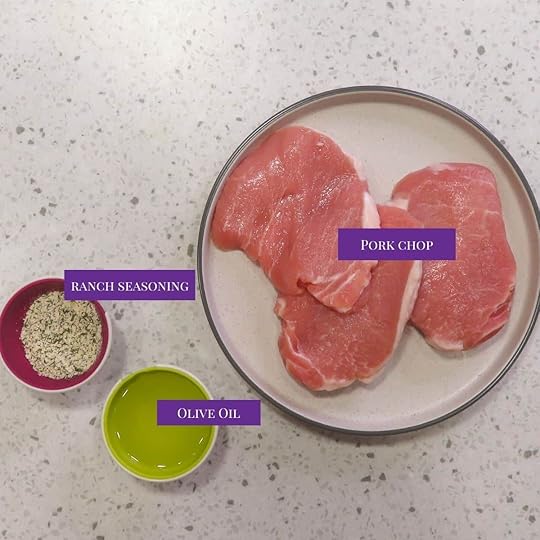 Low Sodium Ranch Seasoning â Adds tangy, herby flavor while keeping sodium levels in check for a kidney-friendly meal.Olive Oil â Provides healthy fats and ensures the pork chops sear beautifully for added flavor.Pork Center Loin, Raw â A lean protein choice thatâs perfect for a CKD-friendly diet when portioned correctly.
Low Sodium Ranch Seasoning â Adds tangy, herby flavor while keeping sodium levels in check for a kidney-friendly meal.Olive Oil â Provides healthy fats and ensures the pork chops sear beautifully for added flavor.Pork Center Loin, Raw â A lean protein choice thatâs perfect for a CKD-friendly diet when portioned correctly.See recipe card for quantities.
How To Make Ranch Pork ChopsCreating these easy ranch pork chops is straightforward and perfect for busy weeknights. With a quick seasoning, a sear, and a short bake in the oven, youâll have a delicious, kidney-friendly meal on the table in no time.
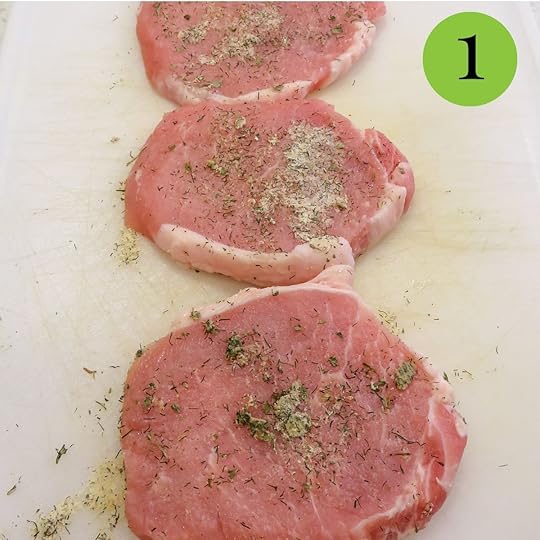 Make the low sodium ranch seasoning for the recipe.
Make the low sodium ranch seasoning for the recipe.Preheat oven to 400°F and line a large rimmed baking sheet with aluminum foil or parchment paper. Set aside.
Rub pork chops with 1-2 tablespoons dry ranch seasoning (divided evenly among all chops), until coated.

2. Heat extra virgin olive oil in a large skillet over medium-high heat before adding seasoned pork chops to skillet. Sear pork chops on each side until browned, approximately 2 minutes per side.
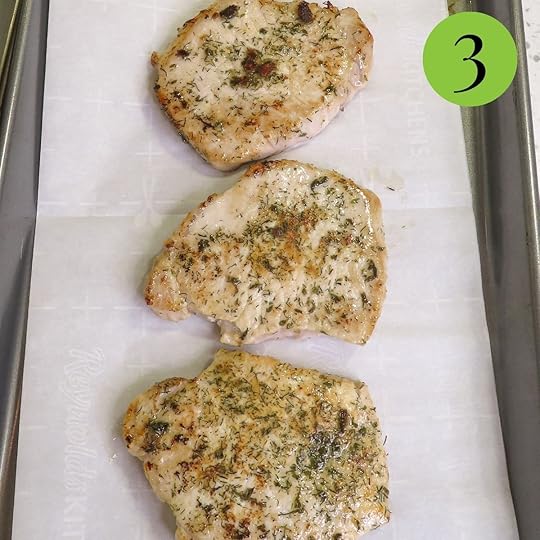
3. Once browned, transfer pork chops to the lined baking sheet, leaving room between each pork chop so they are not over-crowded. Place baking sheet in the pre-heated oven and roast for 8 minutes before turning each chop.
Continue roasting another 8-10 minutes, or until an instant-read thermometer inserted into the thickest portion of the chop reads 145°F (medium-rare) to 160°F (medium).
Remove chops from oven and let rest for 3-5 minutes before serving.
Hint: Prepare extra ranch seasoning and store it in an airtight container for quick use in future recipes.
Variations for Ranch Pork ChopsIf youâre looking to add some variety to your ranch baked pork chops, there are plenty of ways to customize this recipe while keeping it kidney-friendly. These variations let you experiment with flavors and textures, ensuring the meal stays exciting and delicious for every occasion.
Swap the pork chops for boneless, skinless chicken breasts, adjusting the cooking time as needed.Add a sprinkle of fresh herbs, such as parsley or dill, to enhance the flavor profile.Pair the pork chops with roasted low-potassium vegetables like zucchini, bell peppers, or asparagus.StorageProper storage ensures your ranch seasoning pork chops stay fresh and safe to eat:
Reheating Tip: Add a splash of low-sodium broth or water when reheating to prevent the pork chops from drying out.Refrigerator: Store leftover pork chops in an airtight container for up to 3-4 days. Reheat gently in the oven or microwave to retain moisture.Freezer: Wrap individual portions in plastic wrap or aluminum foil, then place them in a freezer-safe bag or container. Store for up to 2-3 months. Thaw in the refrigerator overnight before reheating.Top tipServe the pork chops with a kidney-friendly sauce, like a homemade garlic and herb yogurt sauce, for added moisture and flavor.
FAQCan I use regular ranch seasoning instead of low-sodium?Itâs best to stick with low-sodium ranch seasoning to keep the recipe kidney-friendly and reduce overall sodium intake.
Whatâs the best way to ensure my pork chops stay moist?Searing the chops before baking and allowing them to rest after cooking helps lock in moisture and keep them juicy.
How can I make the seasoning spicier?Add a pinch of cayenne pepper or smoked paprika to the ranch seasoning for a mild kick thatâs still CKD-friendly.
Related Pork Recipes for CKDLooking for other recipes like this? Try these:
 Baked Ranch Pork Chops
Baked Ranch Pork Chops Roast Pork Ribeye
Roast Pork Ribeye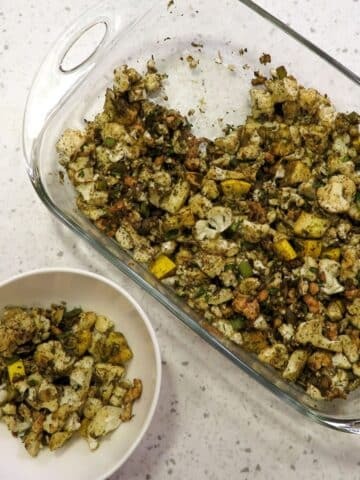 Cauliflower Stuffing with Ground Turkey
Cauliflower Stuffing with Ground Turkey Pork Tenderloin Medallions RecipePairing with Ranch Baked Pork Chops
Pork Tenderloin Medallions RecipePairing with Ranch Baked Pork ChopsThese are my favorite dishes to serve with ranch pork chops:
 Parmesan Carrots
Parmesan Carrots Roasted Red Pepper Pesto Pasta
Roasted Red Pepper Pesto Pasta Wild Rice Stuffing
Wild Rice Stuffing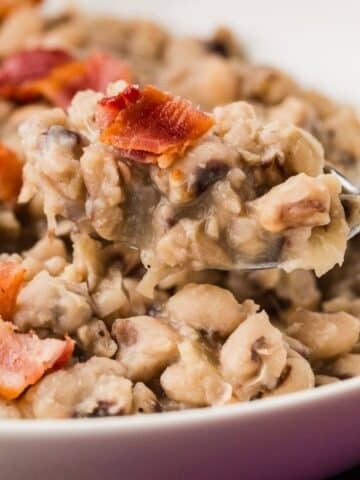 Frozen Blackeyed Peas Recipe
Frozen Blackeyed Peas RecipeIf you tried this Recipe or any other recipe on my website, please please leave a star rating and let me know how it goes in the comments below. I love hearing from you!
Recipe PrintEasy Ranch Pork Chops Recipe#wprm-recipe-user-rating-0 .wprm-rating-star.wprm-rating-star-full svg * { fill: #343434; }#wprm-recipe-user-rating-0 .wprm-rating-star.wprm-rating-star-33 svg * { fill: url(#wprm-recipe-user-rating-0-33); }#wprm-recipe-user-rating-0 .wprm-rating-star.wprm-rating-star-50 svg * { fill: url(#wprm-recipe-user-rating-0-50); }#wprm-recipe-user-rating-0 .wprm-rating-star.wprm-rating-star-66 svg * { fill: url(#wprm-recipe-user-rating-0-66); }linearGradient#wprm-recipe-user-rating-0-33 stop { stop-color: #343434; }linearGradient#wprm-recipe-user-rating-0-50 stop { stop-color: #343434; }linearGradient#wprm-recipe-user-rating-0-66 stop { stop-color: #343434; }#wprm-recipe-user-rating-0.wprm-user-rating-allowed.wprm-user-rating-not-voted:not(.wprm-user-rating-voting) svg * { fill-opacity: 0.3; }Eat these for dinner or lunch or just anytime. If you are looking for some real flavor without adding more salt, you have found it here.  No need to buy pre-packaged ranch dressing or seasoning when it is so easy to make your own. Use the recipe provided below as a guideline, then adjust the seasonings to suit your own tastes. Once youâ ve found the perfect blend, you can mix up larger batches and store the excess in an airtight container for several months. This seasoning is excellent on meats, in homemade salad dressings, or blended with Greek yogurt for a healthy vegetable dip.Course EntreeCuisine AmericanDiet Diabetic, Low Calorie, Low Fat, Low SaltPrep Time 10 minutes minutesCook Time 25 minutes minutesTotal Time 35 minutes minutesServings 4Calories 143kcalAuthor Mathea Ford, RDN, LD, MBAEquipment1 Skillet1 Casserole DishIngredients2 tablespoon Low Sodium Ranch Seasoning1 tablespoon OLIVE OILsalad or cooking12 oz PORK CENTER LOIN RAW, CHOP/ROASTGet ingredients with
PrintEasy Ranch Pork Chops Recipe#wprm-recipe-user-rating-0 .wprm-rating-star.wprm-rating-star-full svg * { fill: #343434; }#wprm-recipe-user-rating-0 .wprm-rating-star.wprm-rating-star-33 svg * { fill: url(#wprm-recipe-user-rating-0-33); }#wprm-recipe-user-rating-0 .wprm-rating-star.wprm-rating-star-50 svg * { fill: url(#wprm-recipe-user-rating-0-50); }#wprm-recipe-user-rating-0 .wprm-rating-star.wprm-rating-star-66 svg * { fill: url(#wprm-recipe-user-rating-0-66); }linearGradient#wprm-recipe-user-rating-0-33 stop { stop-color: #343434; }linearGradient#wprm-recipe-user-rating-0-50 stop { stop-color: #343434; }linearGradient#wprm-recipe-user-rating-0-66 stop { stop-color: #343434; }#wprm-recipe-user-rating-0.wprm-user-rating-allowed.wprm-user-rating-not-voted:not(.wprm-user-rating-voting) svg * { fill-opacity: 0.3; }Eat these for dinner or lunch or just anytime. If you are looking for some real flavor without adding more salt, you have found it here.  No need to buy pre-packaged ranch dressing or seasoning when it is so easy to make your own. Use the recipe provided below as a guideline, then adjust the seasonings to suit your own tastes. Once youâ ve found the perfect blend, you can mix up larger batches and store the excess in an airtight container for several months. This seasoning is excellent on meats, in homemade salad dressings, or blended with Greek yogurt for a healthy vegetable dip.Course EntreeCuisine AmericanDiet Diabetic, Low Calorie, Low Fat, Low SaltPrep Time 10 minutes minutesCook Time 25 minutes minutesTotal Time 35 minutes minutesServings 4Calories 143kcalAuthor Mathea Ford, RDN, LD, MBAEquipment1 Skillet1 Casserole DishIngredients2 tablespoon Low Sodium Ranch Seasoning1 tablespoon OLIVE OILsalad or cooking12 oz PORK CENTER LOIN RAW, CHOP/ROASTGet ingredients with  Instructionshttps://www.renaldiethq.com/low-sodium-ranch-seasoning/ Make the low sodium ranch seasoning for the recipe.Preheat oven to 400°F and line a large rimmed baking sheet with aluminum foil or parchment paper. Set aside.Rub pork chops with 1-2 tablespoons dry ranch seasoning (divided evenly among all 4 chops), until coated. (Store remaining ranch seasoning in an airtight container for later use). Recipe is nutritionally evaluated using 2T of dry ranch seasoning.Heat extra virgin olive oil in a large skillet over medium-high heat before adding seasoned pork chops to skillet. Sear pork chops on each side until browned, approximately 2 minutes per side.Once browned, transfer pork chops to the lined baking sheet, leaving room between each pork chop so they are not over-crowded. Place baking sheet in the pre-heated oven and roast for 8 minutes before turning each chop.Continue roasting another 8-10 minutes, or until an instant-read thermometer inserted into the thickest portion of the chop reads 145°F (medium-rare) to 160°F (medium).Remove chops from oven and let rest for 3-5 minutes before serving.VideoNutritionCalories: 143kcal | Carbohydrates: 1g | Protein: 19g | Fat: 6g | Saturated Fat: 2g | Polyunsaturated Fat: 1g | Monounsaturated Fat: 4g | Trans Fat: 0.02g | Cholesterol: 56mg | Sodium: 45mg | Potassium: 341mg | Fiber: 0.1g | Sugar: 0.3g | Vitamin A: 0IU | Vitamin C: 0mg | Vitamin D: 0.3µg | Calcium: 4mg | Iron: 0.5mg | Phosphorus: 205mgCheck Out Our Meal Plans For People With Chronic Kidney Disease (CKD)
Instructionshttps://www.renaldiethq.com/low-sodium-ranch-seasoning/ Make the low sodium ranch seasoning for the recipe.Preheat oven to 400°F and line a large rimmed baking sheet with aluminum foil or parchment paper. Set aside.Rub pork chops with 1-2 tablespoons dry ranch seasoning (divided evenly among all 4 chops), until coated. (Store remaining ranch seasoning in an airtight container for later use). Recipe is nutritionally evaluated using 2T of dry ranch seasoning.Heat extra virgin olive oil in a large skillet over medium-high heat before adding seasoned pork chops to skillet. Sear pork chops on each side until browned, approximately 2 minutes per side.Once browned, transfer pork chops to the lined baking sheet, leaving room between each pork chop so they are not over-crowded. Place baking sheet in the pre-heated oven and roast for 8 minutes before turning each chop.Continue roasting another 8-10 minutes, or until an instant-read thermometer inserted into the thickest portion of the chop reads 145°F (medium-rare) to 160°F (medium).Remove chops from oven and let rest for 3-5 minutes before serving.VideoNutritionCalories: 143kcal | Carbohydrates: 1g | Protein: 19g | Fat: 6g | Saturated Fat: 2g | Polyunsaturated Fat: 1g | Monounsaturated Fat: 4g | Trans Fat: 0.02g | Cholesterol: 56mg | Sodium: 45mg | Potassium: 341mg | Fiber: 0.1g | Sugar: 0.3g | Vitamin A: 0IU | Vitamin C: 0mg | Vitamin D: 0.3µg | Calcium: 4mg | Iron: 0.5mg | Phosphorus: 205mgCheck Out Our Meal Plans For People With Chronic Kidney Disease (CKD)The post Baked Ranch Pork Chops appeared first on Renal Diet HQ.
December 31, 2024
Healthy New Year For Chronic Kidney Disease Patients
Kick Off a Healthy New Year with Kidney-Friendly Recipes! Ring in the New Year with a delicious and nutritious meal designed for those managing Chronic Kidney Disease (CKD). This festive menu features kidney-friendly dishes that are low in sodium and potassium while bursting with vibrant flavors.
Start with a hearty Roasted Red Pepper Pesto Pasta, made with roasted red bell peppers, fresh basil, and olive oil for a flavorful main dish thatâs both satisfying and nourishing. Pair it with Parmesan Carrots, a savory and naturally sweet side thatâs low in potassium and sodium, and enjoy the refreshing crunch of Broccoli Crunch Salad, a vibrant mix of broccoli, parsley, onions, and sunflower seeds, topped with a creamy dressing made with reduced-fat mayonnaise, honey, and a hint of lemon. To finish your meal, indulge in Cinnamon Baked Pears, a delightful dessert topped with heart-healthy walnuts and a touch of cinnamon to satisfy your sweet tooth.
Get A Copy Of Healthy New Year For Chronic Kidney Disease Patients In Your Inbox Recipes For This Healthy New Year For Chronic Kidney Disease Patients
Recipes For This Healthy New Year For Chronic Kidney Disease PatientsThis balanced and flavorful menu is the perfect way to celebrate a fresh start while supporting your health and well-being. With dishes that are easy to prepare and packed with nutrition, you can welcome the New Year feeling nourished and inspired. Hereâs to a Happy and Healthy New Year! ð¥
As a Registered Dietitian Nutritionist specializing in Chronic Kidney Disease (CKD) and the owner of RenalDietHQ.com, I bring years of experience in guiding individuals toward healthier, kidney-friendly diets. My commitment to providing reliable and practical advice is rooted in evidence-based nutrition practices. This expertise ensures that all recipes and dietary recommendations in this blog are tailored to support those with CKD in leading healthier, more balanced lives.
Start the New Year with a vibrant, kidney-friendly feast thatâs both delicious and nutritious! From a delightful dessert to wholesome sides and a satisfying main dish, these recipes are perfect for celebrating health and flavor in harmony.
Roasted Red Pepper Pesto Pasta Bring bold flavors to your table with this colorful and kidney-friendly pasta. Made with roasted red bell peppers, fresh basil, and olive oil, this dish is as nutritious as it is satisfying, serving as the perfect centerpiece for your New Year celebration.
Parmesan Carrots Add a touch of natural sweetness and savory flair with Parmesan Carrots. Roasted to perfection and lightly seasoned, this low-potassium and low-sodium side dish is a delicious complement to your main course.
Broccoli Crunch Salad Looking for a refreshing and nutritious dish that fits perfectly into your kidney-friendly diet? This Broccoli Crunch Salad is a satisfying blend of textures and flavors, combining creamy, tangy, smoky, and crunchy elements for a truly delightful experience.
Cinnamon Baked Pears Indulge in a healthy and satisfying dessert with these Cinnamon Baked Pears. Topped with heart-healthy walnuts, this treat delivers the perfect balance of natural sweetness and warm spice to end your meal on a high note.
For added ease, this menu is simple to prepare and packed with kidney-friendly ingredients, making it ideal for those managing Chronic Kidney Disease (CKD). Celebrate a Happy and Healthy New Year with this flavorful and balanced spread! ð
With this cohesive menu, you can enjoy a delicious, kidney-conscious feast that celebrates health and flavor. Let this New Year meal set the tone for a happy and healthy year ahead! ð
Roasted Red Pepper Pesto Pasta
Broccoli Crunch Salad
Parmesan Carrots
Baked PearsCheck Out Our Meal Plans For People With Chronic Kidney Disease (CKD)Recent Kidney Friendly Recipes
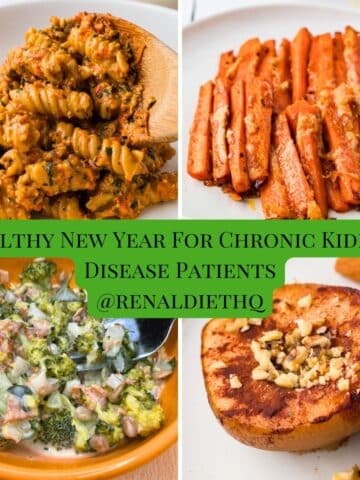 Healthy New Year For Chronic Kidney Disease Patients
Healthy New Year For Chronic Kidney Disease Patients Chicken and Broccoli with Cashews
Chicken and Broccoli with Cashews Parmesan Carrots
Parmesan Carrots Baked Pears
Baked PearsThe post Healthy New Year For Chronic Kidney Disease Patients appeared first on Renal Diet HQ.
December 27, 2024
Eating Fruits And Vegetables with CKD-Podcast

Balancing potassium levels is an essential aspect of health management, especially for individuals with kidney disease. High potassium levels in the blood can pose serious health risks, so understanding how to manage potassium intake through diet is crucial. In this blog post, weâll explore how to choose low-potassium fruits and vegetables that help maintain a delicious and safe diet.
For More Recipes and Ideas --->> Get Your Free Meals and Recipes That Are Perfect for Pre-Dialysis Diets, Pre-Dialysis with Diabetes, or Dialysis Diets.
What is Potassium and Why Does it Matter?Potassium is a vital mineral responsible for key functions in the body, including nerve transmission, muscle contraction, and overall cell function. However, when your kidneys arenât working properly, excess potassium can accumulate in the blood, leading to dangerous health complications. This makes it critical for those with kidney disease to monitor their potassium intake and keep track of their lab results regularly.
What Defines a Low-Potassium Food?Foods are generally categorized as high in potassium if they contain more than 200 milligrams of potassium per serving. Common high-potassium foods to limit include bananas, oranges, cantaloupe, and potatoes. For those needing to reduce their potassium intake, focusing on foods with less than 200 milligrams of potassium per serving is a safer choice. These low-potassium options are just as nutritious and versatile, making it easy to maintain a healthy diet.
Low-Potassium Fruits and Vegetables to Include in Your DietThe good news is there are plenty of delicious low-potassium fruits and vegetables to choose from. Here are some excellent options:
Fruits:ApplesBerries (such as strawberries, blueberries, and raspberries)PearsVegetables:Green beansCucumbersLettuceEach of these contains less than 200 milligrams of potassium per serving, making them ideal for a kidney-friendly diet. Additionally, these ingredients are versatile, so you can enjoy them in various meals throughout the day.
Delicious and Simple Ways to Incorporate Low-Potassium FoodsIncorporating low-potassium foods into your daily meals doesnât have to be complicated. Here are some meal ideas to inspire you:
Breakfast: Start your day with a refreshing berry smoothie made with apple juice as the base.Lunch: Enjoy a crisp salad featuring cucumbers and lettuce for a light and satisfying meal.Dinner: Add steamed green beans as a flavorful side dish to your main course.When grocery shopping, always check the nutrition labels for potassium content, especially in processed foods, where potassium can be unexpectedly high. Paying attention to portion sizes is also critical, as larger servings can inadvertently increase your potassium intake.
Portion Sizes and Meal Preparation TipsManaging portion sizes is a key strategy for controlling potassium intake. Always follow the recommended serving sizes on nutrition labels to avoid consuming too much potassium.
Another helpful tip is to double-boil your vegetables. This simple cooking method significantly reduces the potassium content, making them safer to eat for those with kidney concerns. Thoughtful meal preparation not only helps you manage your potassium levels but also ensures your meals remain flavorful and satisfying.
Consult a Dietitian for Personalized GuidanceWhile these tips are a great starting point, consulting a dietitian is essential for creating a diet plan tailored to your specific health conditions and nutritional needs. A registered dietitian can provide expert guidance, helping you navigate your dietary restrictions while ensuring you still enjoy a diverse and flavorful diet.
Balancing potassium levels doesnât mean sacrificing variety or taste in your meals. By choosing low-potassium fruits and vegetables and preparing them wisely, you can support your health while enjoying delicious food.
If you found this information helpful, subscribe to our blog for more health tips. Weâd love to hear from you, so feel free to drop your questions and share your experiences in the comments below. Stay healthy, and weâll see you next time!
Learn more about Top Tips for Finding LowSodium Canned Foods on a CKD Diet-Podcast
The post Eating Fruits And Vegetables with CKD-Podcast appeared first on Renal Diet HQ.
Mastering SMART Goals for Chronic Kidney Disease Take Control of Your Health Today-Podcast

Living with chronic kidney disease (CKD) can be challenging, but it doesnât have to define your life. One of the most effective ways to take control of your health is by setting SMART goals. SMART stands for Specific, Measurable, Achievable, Relevant, and Time-bound. By breaking down your health objectives into clear and actionable steps, you can move beyond vague promises and work toward tangible results.
For More Recipes and Ideas --->> Get Your Free Meals and Recipes That Are Perfect for Pre-Dialysis Diets, Pre-Dialysis with Diabetes, or Dialysis Diets.
SMART goals empower individuals with CKD to focus on meaningful changes, track progress, and make necessary adjustments. This structured approach not only fosters hope but also enhances a sense of independence and confidence in managing your health.
Why SMART Goals Are Essential for CKD ManagementSetting SMART goals is a powerful strategy for anyone managing CKD. This framework provides a clear plan that encourages positive change and measurable progress. For example:
Specific: A goal like âI will cook dinner at home at least five nights a weekâ provides clarity.Measurable: Track your progress by keeping a food log.Achievable: Choose realistic goals, such as cooking meals at home instead of eating out.Relevant: Align your goals with kidney health, like following a renal-friendly diet.Time-bound: Set a deadline, such as achieving this goal within a month.These elements ensure that your goals are well-defined and actionable, making it easier to focus on improvements that matter most for your kidney health.
Examples of SMART Goals for CKD PatientsCrafting effective goals involves understanding the lifestyle changes necessary for CKD management. Here are some examples:
Reduce Sodium Intake: âI will limit my daily sodium intake to 2,300 mg by avoiding processed foods and using herbs instead of salt for seasoning.âIncrease Physical Activity: âI will walk for 20 minutes a day, five days a week, and track my steps using a fitness app.âManage Medications: âI will set daily alarms to ensure I take my medications at the prescribed times.âThese goals not only improve kidney health but also enhance overall quality of life.
Measuring Progress and Adjusting GoalsTracking progress is vital to achieving your health objectives. Regularly monitor changes in your condition and lifestyle, such as:
Diet and exercise routinesMedication adherenceVital signs like blood pressure and weightMental health through self-reflection on mood and motivationRegular check-ins with healthcare providers can help assess whether treatments are working and provide opportunities for necessary adjustments. Celebrate small successes along the way to stay motivated and reinforce positive behaviors.
Dealing with Setbacks and Staying MotivatedManaging CKD is not without its challenges. Setbacks are inevitable, but they should not discourage you. Instead, focus on the bigger picture and remember that consistency over time yields results. Coping strategies include:
Celebrating small wins to build momentumAcknowledging feelings of overwhelm and taking breaks to rechargeEngaging in self-care activities like yoga or meditation to reduce stressLean on your support network of family, friends, and healthcare professionals to stay committed to your goals.
Creating a Personalized Action PlanAn action plan is essential for achieving your SMART goals and improving your health. Follow these steps:
Identify Specific Goals: Focus on areas like nutrition, weight management, and physical activity.Break Down Goals into Tasks: Create smaller, manageable steps with deadlines.Track Progress: Use tools like journals, apps, or support groups to stay accountable.Consult Healthcare Professionals: Tailor your goals to your stage of CKD and receive guidance on safe and effective management strategies.Celebrate Milestones: Reward yourself for achievements to maintain motivation.Empowering Your CKD JourneyLiving with CKD requires patience, resilience, and a proactive approach. By setting SMART goals, you can take control of your health and improve your quality of life. Remember to celebrate your progress, adjust your goals as needed, and seek support from loved ones and healthcare professionals. With dedication and the right strategies, you can navigate the challenges of CKD and achieve meaningful improvements in your well-being.
Learn more about Eating Fruits And Vegetables with CKD-Podcast
The post Mastering SMART Goals for Chronic Kidney Disease Take Control of Your Health Today-Podcast appeared first on Renal Diet HQ.



